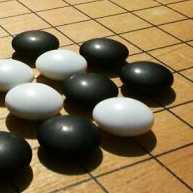Internet Go server
| Part of a series of articles on |
| Go |
|---|
 |
| Game specifics |
|
| History and culture |
| Players and organizations |
| Computers and mathematics |
An Internet Go server is a server that allows players of the game of Go to play against other players online. The two fundamental types of Go server are real-time servers and turn-based servers.
History
The first Go server that started operating is the Internet Go Server (IGS), which began service in 1992[1] and is still active today. Several other servers, all with the same basic server-client architecture, followed.[2]
When initiated the IGS was resident at the University of Pennsylvania mainframe system without official permission from the university. For reasons that were never publicly stated, it then migrated to the University of California where it remained, purportedly with the knowledge of the university, until it outgrew the allotted memory. The server was then at some risk until the Nihon Ki-in decided to host it in Japan on dedicated servers, where it remains today.
Real-time servers
Real-time Go servers allow players to play against other in real time when both are online at the same time. Generally, this involves a setup where both players use a client program to connect to the server, which then relays the moves from player to player. The server also keeps track of time controls, calculates the score and, if applicable, calculates ratings for the players based on their results. Such servers require players to download a client program, and many such programs have been developed for a wide range of platforms.[2] Around 2000, Kiseido publishing started the Kiseido Go Server (KGS), which allowed players to play without downloading a client by utilizing a Java applet in the web browser. This server quickly became popular and still is today. IGS and KGS are currently (2014) the most popular servers for the English-speaking audience.[3] Currently Online Go Server (OGS) is capable to both Real-time and Turn-based games[4] straight from webbrowser.
Turn-based servers
Turn-based servers do not require opponents to be online at the same time. Instead, a player records a move with the server, and the server will present this move to the opponent the next time he connects to the server. This way, players need never be online simultaneously and can still play against each other. Turn-based servers also keep track of time controls, but these are generally measured in days, instead of minutes as is customary on real-time servers. Online Go Server (OGS) and Dragon Go Server (DGS) are currently the most popular turn-based go servers.[3]
References
- ↑ Jim Z. Yu A Brief History of IGS, the Early Years - 1992 & 1993 Retrieved on 2007-12-11
- ↑ 2.0 2.1 British Go Association. "Go Servers - A Short History". Retrieved 2007-12-11.
- ↑ 3.0 3.1 British Go Association. "Internet Go". Retrieved 2007-12-11.
- ↑ Sensei's Library. "Online-go Server". Retrieved 20014-04-07. Check date values in:
|accessdate=(help)
External links
- List of Internet Go servers on Sensei's Library.
- List of Internet Go servers on the AGA website.
- List of Internet Go servers on the FICGS website.
- List of teaching services on the BGA website.